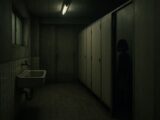Aka Manto: The Definitive Guide to Japan's Terrifying Red Cape Ghost of the Toilet
Aka Manto: The Definitive Guide to Japan’s Terrifying Red Cape Ghost of the Toilet
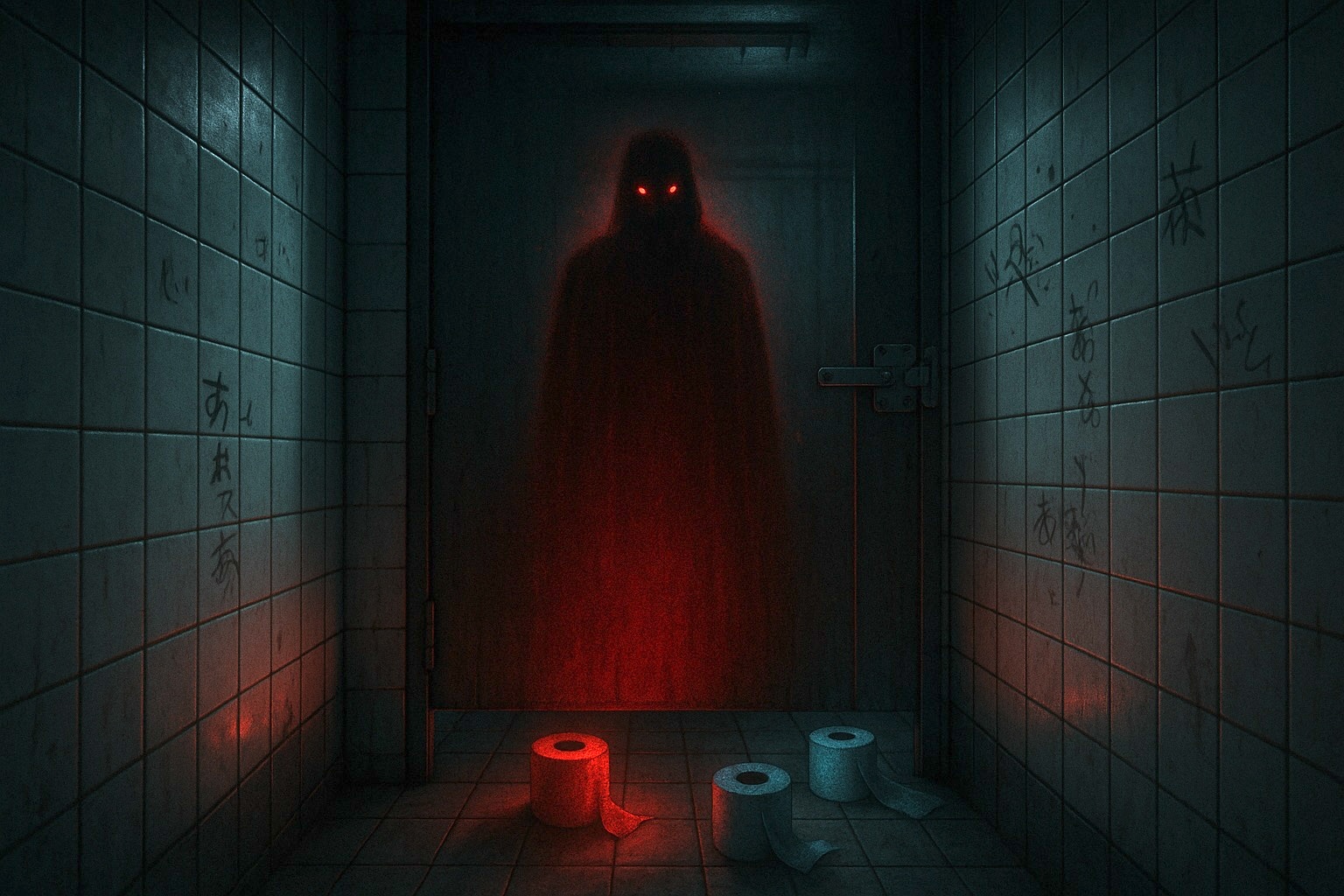
In the shadowy corners of every Japanese school bathroom, a terrifying urban legend lurks. It tells of a mysterious figure who appears when you are at your most vulnerable, offering a choice with no right answer. This is the story of Aka Manto, the Red Cape ghost, one of Japan’s oldest and most chilling supernatural entities.
This is not just another ghost story. The legend of Aka Manto is a complex tapestry of pre-war social panic, unsolved mysteries, and deep-seated cultural anxieties surrounding the most private of spaces. It is a tale that has evolved over nearly a century, from a child-snatching boogeyman to the iconic toilet-dwelling specter known today. This is the definitive guide to the entity, the legend, and the deadly choice it presents.
Editor’s Note: This deep dive into Aka Manto is part of our central collection, The Definitive Guide to Japanese Urban Legends. Explore the full series to uncover all of Japan’s most terrifying modern myths.
The Legend: A Choice with No Escape
The modern legend of Aka Manto is a masterclass in psychological horror, a deadly trap sprung in the isolation of a bathroom stall. The scenario is deceptively simple:
While using a toilet, usually the last stall in a school bathroom, a mysterious, disembodied voice will ask a question:
“Akai kami, aoi kami, dochira ga hoshii ka?”
(“Red paper or blue paper, which do you want?”)
Your response seals your fate.
・If you choose “red paper,” you will be brutally stabbed or flayed until your clothes are stained crimson red, as if you are wearing a red cape (aka manto).
・If you choose “blue paper,” all the blood will be drained from your body, leaving you a blue-faced, lifeless corpse on the floor.
Choosing a third color, like yellow, often results in an even worse fate, such as being dragged directly to the underworld. The only way to survive, some whisper, is to refuse the offer entirely by saying “I don’t need any paper” or to simply run. But often, the stall door is mysteriously locked, leaving no escape.
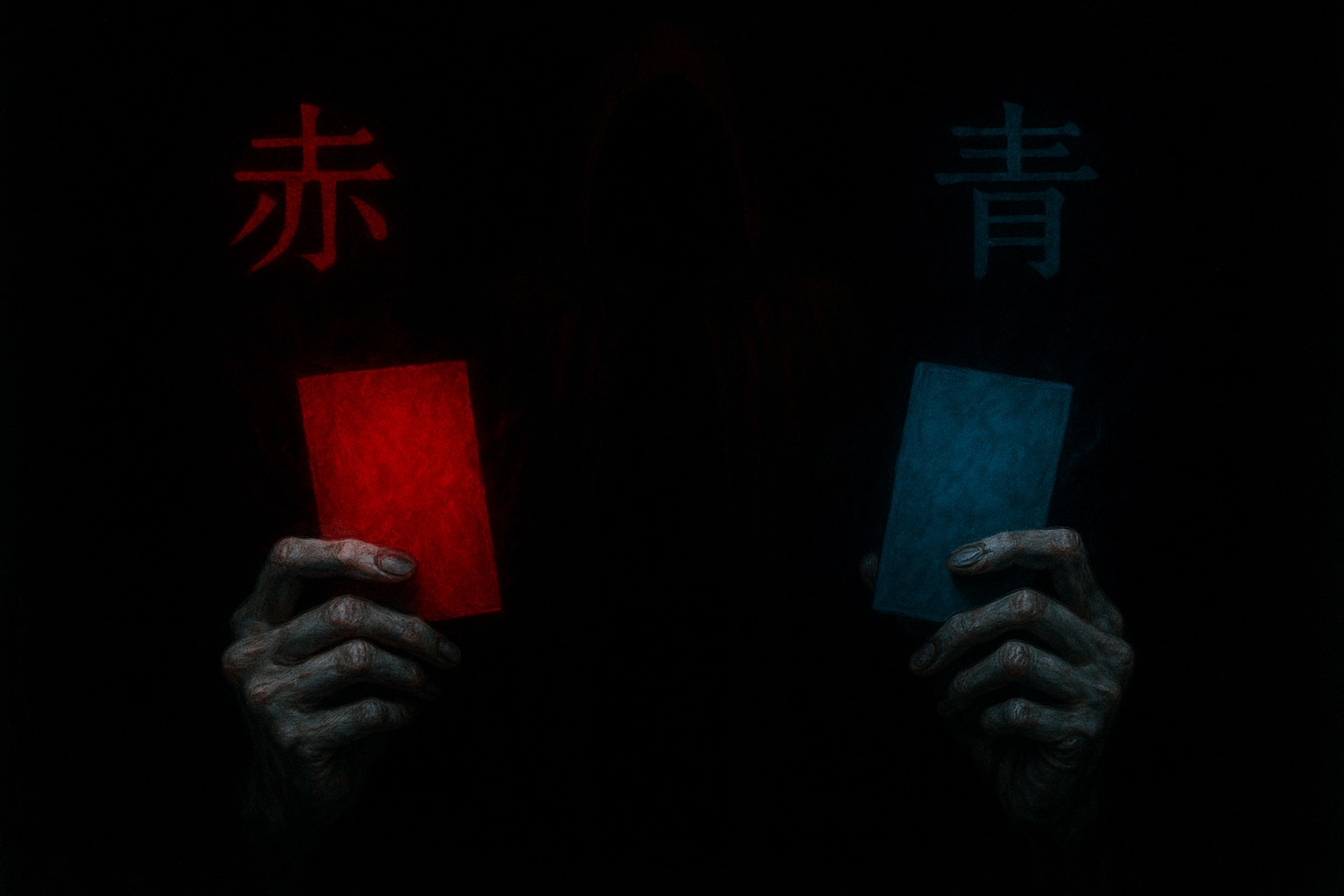
The Origins: From Pre-War Boogeyman to Bathroom Ghost
Unlike many modern urban legends, Aka Manto’s roots run deep, tracing back to the 1930s, long before the famous Hanako-san of the Toilet. The legend evolved through several distinct phases:
Phase 1: The “Aka Manto” Child Snatcher (1930s-1940s)
The earliest form of the legend was not a toilet ghost, but a terrifying boogeyman who stalked the streets. Rumors, which began around 1936, spoke of a mysterious man in a red cape who would abduct and murder children, particularly young girls.
This “Aka Manto” figure sparked a genuine social panic. In 1939, the hysteria in Tokyo was so intense that the police had to make a public radio announcement debunking the rumor. The story spread purely by word of mouth, traveling from Tokyo to Osaka and even to Japanese communities in Korea, a testament to its terrifying power in an era of growing social anxiety and war-time paranoia.
The origin of this boogeyman is debated. Some folklorists connect it to a real, unsolved 1906 kidnapping case known as the “Blue Blanket Man” incident. Others, like historian Joji Asakura, suggest it was a twisted rumor born from the government’s information blackout following the failed military coup of the February 26 Incident in 1936. With the truth suppressed, public fear manifested as a monstrous, blood-sucking phantom.
Phase 2: The School Ghost (Post-War)
After World War II, the legend mutated. The street-roaming monster retreated into the confines of the school, a space that was rapidly becoming the center of children’s lives and fears. An early version of the story from the 1930s in Osaka already told of a caped figure appearing in a school’s dark shoe locker area.
This school-based version eventually migrated to the most liminal and feared space of all: the toilet. The figure of Aka Manto became intertwined with the act of choosing, a theme that resonated with the pressures of school life, such as exams where a wrong answer had serious consequences.
Phase 3: “Red Paper, Blue Paper” (1980s-Present)
The final evolution into the “Red Paper, Blue Paper” toilet legend we know today was cemented in the 1980s during Japan’s second occult boom. Popularized by horror writers and late-night radio shows, this version became the definitive form, a staple of “School’s Seven Mysteries” alongside Hanako-san and the Kuchisake-onna (the Slit-Mouthed Woman).
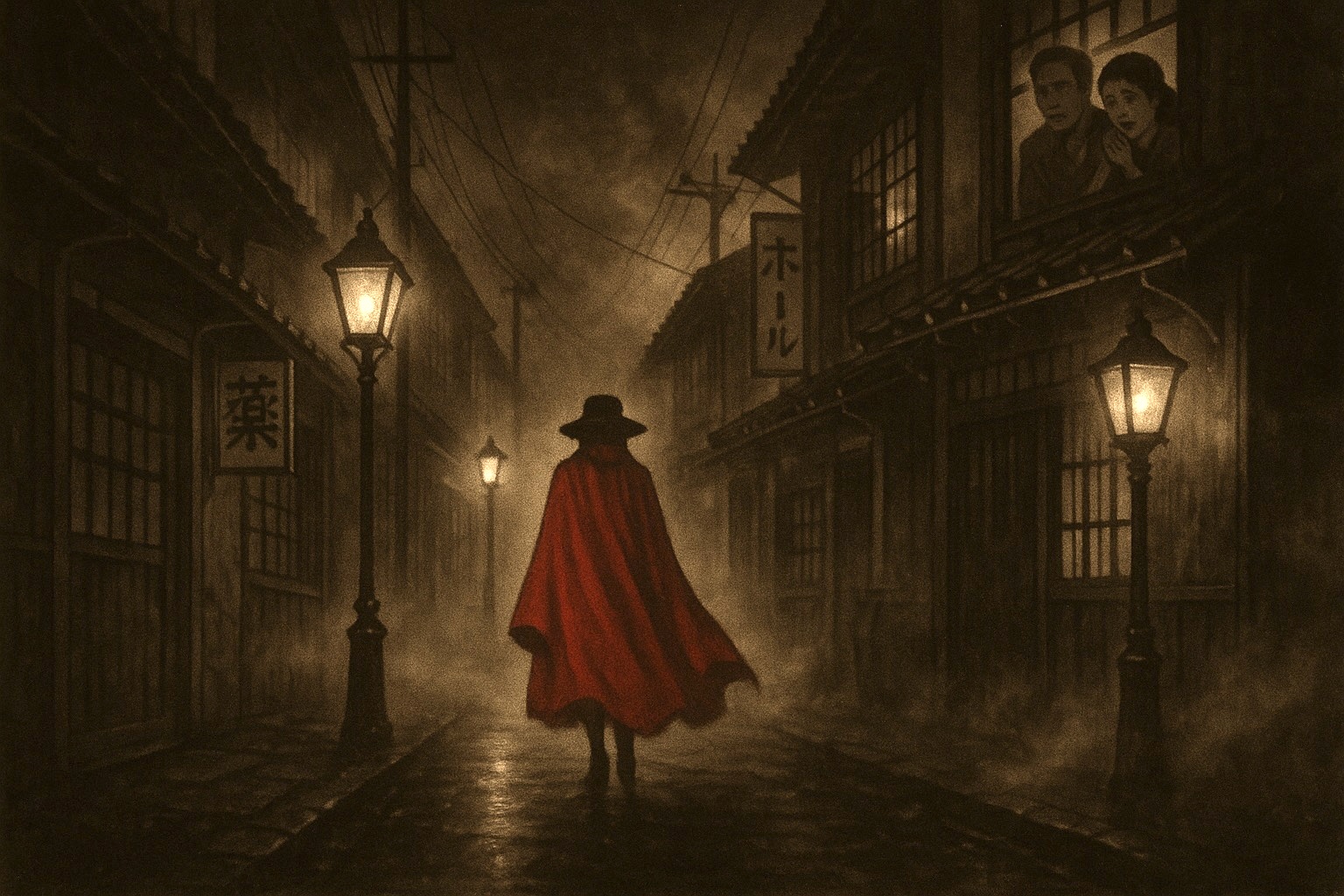
Cultural and Psychological Significance: Why a Toilet Ghost?
The legend of Aka Manto is deeply rooted in Japanese culture and psychology.
・The Toilet as a Sacred and Profane Space: In traditional Japanese folklore, the toilet (kawaraya) was considered a gateway to another world, a place of both impurity and divine presence. It was protected by a deity (kawaraya no kami), and rituals were performed to appease it. The Aka Manto legend can be seen as a modern, terrifying corruption of this ancient belief, turning a guardian deity into a malevolent ghost.
・The Symbolism of Color: The choice between red and blue is culturally potent. Red is the color of blood, violence, and passion, but also of sacred protection (as seen in the red torii gates of shrines). Aka Manto’s “red” fate is a direct and brutal manifestation of this. Blue (or sometimes white in older versions) is the color of death, representing the pale, bloodless complexion of a corpse.
・The Fear of the Unavoidable Choice: The legend’s core horror lies in its “no-win” scenario. This resonates with the universal fear of being trapped in a situation with no good outcome, a feeling that children often experience in the face of authority or academic pressure. Aka Manto is the ultimate unfair test.
Aka Manto in Modern Pop Culture
While not as internationally famous as Sadako from The Ring or the Kuchisake-onna, Aka Manto has left a distinct mark on Japanese pop culture, particularly in horror and gaming.
Manga and Anime: The legend was famously adapted in the popular 1990s manga and anime series Hell Teacher Nūbē, where a masked monster named “A” terrorizes schoolchildren, becoming a source of childhood trauma for many readers.
Video Games: The indie horror game developer Chilla’s Art brought the legend to a global audience with their 2019 game, Aka Manto. The game traps players in a haunted school, forcing them to solve puzzles while being relentlessly stalked by the red-caped killer.
International Recognition: The legend has spread overseas, particularly to South Korea, where “Red Paper, Blue Paper” (ppalgan jong-i, paran jong-i) is a well-known school ghost story. In the West, it is a recurring topic on horror forums and YouTube channels, often compared to the “Bloody Mary” ritual but noted for its unique, inescapable choice.
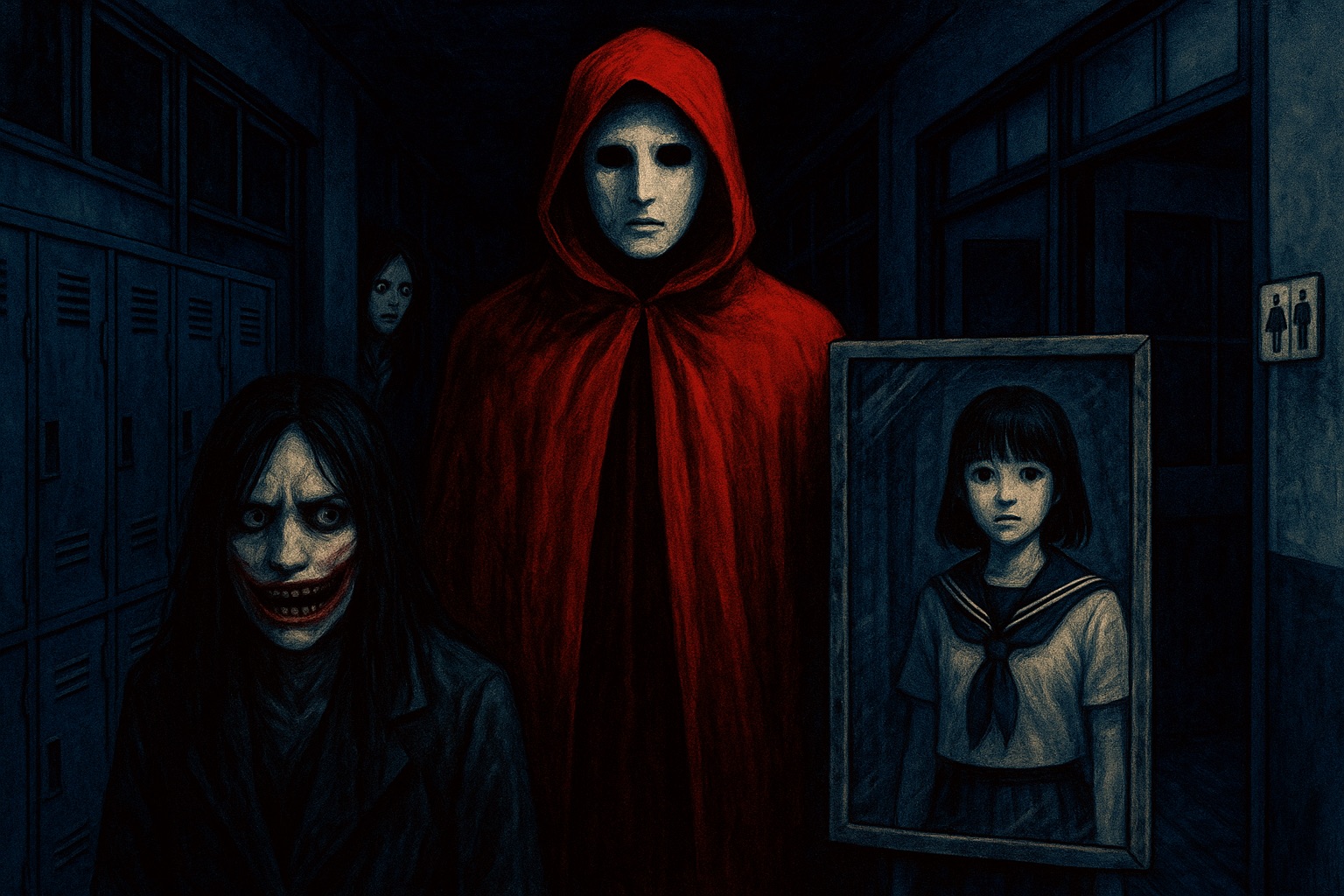
The story of Aka Manto is a powerful example of how a legend can adapt and endure. It began as a reflection of real-world fears—of kidnappers, of war, of the unknown—and transformed into a supernatural test of wits in the most vulnerable of places. It is a chilling reminder that even in the most mundane moments of life, a terrifying choice could be waiting just on the other side of the stall door.
The Terror Doesn’t End Here
The chilling tale of Aka Manto is just one piece of a much larger, darker puzzle. Our central hub features in-depth guides to all of Japan’s most iconic modern nightmares.
※ Unauthorized reproduction, video creation, and uploading of this article's content to YouTube, blogs, or other platforms is strictly prohibited.
Related Articles

Jinmenken: The Definitive Guide to Japan’s Eerie Human-Faced Dog

Hanako-san: The Terrifying Legend of the Japanese Ghost in the Bathroom Stall

Kuchisake-Onna: The Definitive Guide to Japan’s Terrifying Slit-Mouthed Woman

Tsuchinoko: The Definitive Guide to Japan’s Legendary Snake Monster and its $1 Million Bounty
Popular Series
This is the page for Aka Manto: The Definitive Guide to Japan’s Terrifying Red Cape Ghost of the Toilet. Find the latest news about Folklore, Horror, Akamanto, SchoolGhost and more on TOCANA - the paranormal news media that stimulates your curiosity
Urban Legends Latest Articles
The Definitive Guide to Japan's Scariest Urban Legends: From Kuchisake-Onna to Kisaragi Station
2025.10.20 23:00 Urban LegendsKunekune: The Definitive Guide to Japan's Terrifying, Twisting Field Monster
2025.10.19 23:00 Urban LegendsNNN Special Broadcast: The Definitive Guide to Japan's Lost, Lethal TV Broadcast
2025.10.14 23:00 Urban Legends
